
Website founded by
Milan Velimirović
in 2006
18:08 UTC


| |
MatPlus.Net  Forum Forum  Helpmates Helpmates  Analysing helpmates in 2 Analysing helpmates in 2 |
| |
|
|
|
|
You can only view this page!
| | Page: [Previous] [Next] 1 2 3 | | (1) Posted by Harry Fougiaxis [Tuesday, Jul 3, 2007 22:15] | Analysing helpmates in 2
Some may consider that helpmates in 2 are the easiest genre to be analysed. It seems quite logical, after all most of them only have two short lines of play. As Chris Feather has repeatedly mentioned, the difficulties arise when one quits examining what the moves do and he starts to study why the moves are done; in other words, when he appreciates the departure and arrival effects of the moves.
Let me quote a recent example.
Aleksandr Pankratiev
3 HM Chess Leopolis 2006
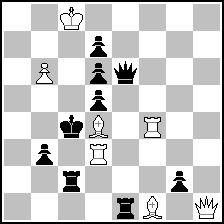 (= 7+9 ) (= 7+9 )
h#2
2.1.1.1
1.Qe2 Bc3+ 2.Kxd3 Qh3#
1.Qe4 Rc3+ 2.Kxd4 Qh8#
So, a couple of quiz :
1. What is wrong in this problem?
2. Can you make it in Meredith? (I didn't manage, I need one useless king more...) No tricks with twinning please, you keep the queen inside for the mates!
3. Do you see how double-pin mates (in each solution, of course) can be arranged? Note: this challenge has been achieved. In that matrix, one of the battery front pieces is changed and 18 pieces were necessary (remember, you must keep the wQ mates!)
| | | (2) Posted by Abdelaziz Onkoud [Wednesday, Jul 4, 2007 01:30] |
Cher ami Harry ,
En voici un essai qui économise deux pièces noires. Dommage que le Fou Blanc c8 est inutile dans la deuxième solution.
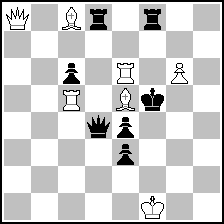 (= 7+7 ) (= 7+7 )
Blancs : Rf1 Da8 Té6ç5 Fç8é5 Pg6
Noirs : Rf5 Dd4 Td8f8 Pç6é4é3
h‡2 (7+7)
1.Dd7 Ff6+ 2.R×é6 D×ç6‡
1.Dd5 Tf6+ 2.R×é5 Da1‡
| | | (3) Posted by Abdelaziz Onkoud [Wednesday, Jul 4, 2007 02:19] |
Rebonjour Cher Harry,
Voici une version ou le Fou blanc se sentira plus utile!
Amitiés
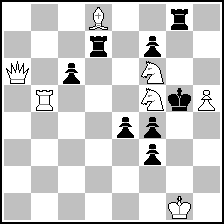 (= 7+8 ) (= 7+8 )
Blancs : Rg1 Da6 Tb5 Fd8 Cf6f5 Ph5
Noirs : Rg5 Tg8d7 Pf7ç6é4f4f3
h‡2 (7+8)
1.Té7 Cg7+ 2.R×f6 Da1‡
1.Td5 Cg4+ 2.R×f5 Dç8‡
| | | (4) Posted by Thomas Maeder [Wednesday, Jul 4, 2007 08:45] |
QUOTE
1. What is wrong in this problem?
First of all that the wBf1 is unused in one mate.
I also don't like the check prevention on the c file. The primary reason for the white pieces to move to c3 is to guard a flight; I would consider the rook c2 a weasel.
Finally, I would try to get rid of the other black rook as well; having the two line pieces on the e file would be nice if they exchanged functions between solutions.
| | | (5) Posted by Harry Fougiaxis [Wednesday, Jul 4, 2007 19:54]; edited by Harry Fougiaxis [07-07-08] |
Well done Thomas, up to the point! Let's see first if the bRe1 is necessary. The composer needed some piece on that square so that the bQ cannot block on b4, so he unfolds his first cheat : let it be a rook, we get anti-Bristol interferences for free that way. Of course, it is not so interesting, as Thomas explained, it would be much better if we had reciprocal interferences. Ok, what if we remove the bQ and move the bRe1 to e5, removing at the same time the black pawns d6/d7? Yes, it works as you would expect.
Now, let's examine the check prevention on the c file : Thomas is right again, the white pieces have to play to c3 anyway, it is irrelevant that they close the rook-line. However, you cannot simply replace the bRc2 with a pawn, or move the wK somewhere else, there are too many cooks. Yet, it is still possible, if you move the white pawn from b6 to c5 (you don't need the line after all!)
I know that many (incl. some h# experts) would not mind so much about the artificial effect of the check prevention along the c file. Personally I do not appreciate much such effects, which are not genuine and they are only added for decoration.
 (= 7+6 ) (= 7+6 )
h#2
2.1.1.1
Of course, this version does not cope with the defect of the bishop sleeping in one solution...
I like the second version by Abdelaziz, which gets rid of the artificial anti-Bristol interferences. The black line closings are still here, but again imho they are neither convincing nor desirable. Why do we need them, isn't the dual-avoidance of Sd4? and Sd7? that close the potential wQ mating lines thematically more preferable? Why should we add another line (that of the black royal battery), when it is not really necessary and the base scheme works its magic by itself? Of course there are cooks, I know...
This reminded me of one of my own compositions, where my aim was to arrange the check prevention as the only arrival effect of the W1 moves, here you are :
Harry Fougiaxis
Probleemblad 2002
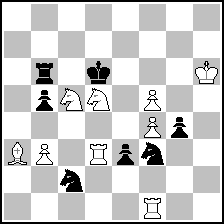 (= 9+7 ) (= 9+7 )
h#2
b)  f1 f1
a) 1.Sb4 Sf6+ 2.Kxc5 Rc1#
b) 1.Sfd4 Se6+ 2.Kxd5 Bg2#
And about the challenge of point (3) : we need an additional pin-line, what about an anticipatory black half-pin?
Fadil Abdurahmanović
1 Pr Sredba na Solidarnosta 1985
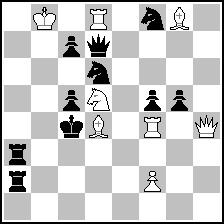 (= 8+10 ) (= 8+10 )
h#2
2.1.1.1
1.Se4 Sb4+ 2.Kxd4 Qh8#
1.Qe6 Bc3+ 2.Kxd5 Qh1#
| | | (6) Posted by Ricardo de Mattos Vieira [Thursday, Jul 5, 2007 04:05] |
I would like to suggest:
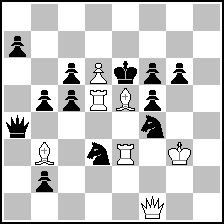 (= 7+12 ) (= 7+12 )
1.Qc4 Bxf4 2.Kxd5 Qxd3#
1.Qe4 Rdxd3 2.Kxe5 Qxf4#
The bQ acts as a R in the solutions but it avoids 1.S(d3) any Qxb5 2.cxd5 Qe8# .
In the mating position of the first solution, the wB that captured the bS does not guard any square and the motivation for the move 1. … Bxf4 is to eliminate the bS.
In the mating position of the second solution, the wR that captured the bS guards d4 but it already did it in the diagram position and the motivation for the move 1. … Rxd3 is also (and only) to eliminate the bS.
Considering the first diagram, the author might have wanted to show a visual effect of both wB and wR moving to the same square (c3) in W1. If this is correct and in order to keep as much as possible his intention and in order to eliminate the idle wB in one of the solutions, I moved this visual effect from c3 (in the original diagram) to the mating squares.
| | | (7) Posted by Harry Fougiaxis [Thursday, Jul 5, 2007 20:42] |
I hope you wouldn't mind if I present another example, I should say rather controversial and quite surprising this time. I presented this problem in a mini-lecture that I gave a couple of years ago during a Belgrade meeting with the audience actively participating in hunting for weasels.
Tode Ilievski
4 Pr Orbit 2003/I
 (= 8+8 ) (= 8+8 )
h#2
2.1.1.1
1.Qxg3 d3+ 2.Kf3+ Sd4#
1.Qxf6 Sc3+ 2.Ke5+ d4#
The judge commended : "Distant self-blocks with capture of a white piece which pins in the other solution. Anticritical moves and pin-models on the same square add to the content of this excellent problem".
What do you think, is it really so?
| | | (8) Posted by Ricardo de Mattos Vieira [Thursday, Jul 5, 2007 21:59] |
 (= 5+3 ) (= 5+3 )
H # 2
2.1.1.1.
same solutions
| | | (9) Posted by Harry Fougiaxis [Thursday, Jul 5, 2007 22:24]; edited by Harry Fougiaxis [07-07-05] |
Excellent Ricardo, don't be surprised if you are invited to be the h#2 judge for next year :)
As Chris Feather wrote once for a similar case (I think in Black to Play, but I may be wrong), these who may be surprised that nothing much of a problem is left in the end, may want to re-consider if there were indeed a problem from the beginning (even if this near-miniature is certainly sweet, but just that...)
| | | (10) Posted by Jacques Rotenberg [Thursday, Jul 5, 2007 23:06] |
Well Harry,
Your question is excellent, and the 'version' very economic...
But I must say that the problem of Ilievsky is excellent too.
And the 'version' has, of course, no value.
I cannot explain with simple words why it seems to me so evident.
The Prize received is well deserved.
Maybe an excellent proof that hunting weasels have some limits
| | | (11) Posted by Juraj Lörinc [Friday, Jul 6, 2007 08:40] |
Personally, I tend to agree with Jacques. Some time ago I have studied weasels quite extensively (motivated by writings of others) and I came to conclusion that more often they add more (graphically and strategically) than they subtract (in economic and strict motivation requirements sense). As a result, they have to be studied on a case-by-case basis and I tend to diminish value of the problem only in a case that my feeling says me "all right, there is something wrong with the problem..."
| | | (12) Posted by Harry Fougiaxis [Friday, Jul 6, 2007 12:04]; edited by Harry Fougiaxis [07-07-06] |
That's why I wrote that it is a controversial case. The captures, the pins and the cross-checks are of course visually pleasant, but they are not an inherent part of the matrix. Personally I cannot consider a problem whose strategic effects are fake and imposed by the composer as excellent. A little girl ("the basic setup") may use a lot of make-up to look sexy (the "pushed" prize-winner), and this will make her desirable for sure, but not necessarily a beautiful woman per se.
| | | (13) Posted by David Knezevic [Friday, Jul 6, 2007 12:39] |
Harry, I cannot agree with you at all!
Chess composing, like other types of creation, relies on "cosmetics". Like in the nature, it is almost impossible for a living being (=chess problem) to survive without it.
The analysis like the one you just demonstrated may help us to make the conclusion about the "weight" of the content, but artistic and aesthetic impression is what really matters. And they are usually in opposite proportion to a "weight".
By the same logic, one could argue that performing a music piece by a philharmonic orchestra is a "cosmetics" rather than inherent part of the main theme - it can be simply whistled.
A comparison with sexy girls is perhaps good, unfortunately I (we?) usually don't have the opportunity to examine "the basic setup" ;)
| | | (14) Posted by Ricardo de Mattos Vieira [Saturday, Jul 7, 2007 02:32] |
I would like to suggest:
 (= 9+5 ) (= 9+5 )
H # 2
2.1.1.1.
same solutions
Analyzing the original helpmate, I realized that the bQ critical moves were very important to the author (what is bBd6 for? a wPe5 helps a lot!). Both the critical moves and the check avoidance were used to determine the order of the black moves, although only one reason would be enough. And the existence of these two reasons is why the original helpmate can turn to the (economic, near-miniature, sweet and with no value) version I presented before.
Unfortunately I could not keep the bQ critical moves and eliminating them was the key to make the bR essential (to keep the right order of the black moves). As a consequence, the wR and wB were justified.
In this version, the cross-checks are accidental (they already were). The cross-checks occur but do not determine the mating moves and are not essential. I tried to come to a position in which the cross-checks were essential but I did not succeed. (I ask someone’s help.)
I think this version presents strategic effects that are necessary for the solutions. I just would not send it (award it) if the tourney had the exigency of cross-checks (which was not the case).
| | | (15) Posted by Ricardo de Mattos Vieira [Saturday, Jul 7, 2007 02:37] |
Sorry.
The solutions are not the same.
The B1 moves are made by the bSh5 (1.Sxf6 and 1.Sxg3).
| | | (16) Posted by Thomas Maeder [Saturday, Jul 7, 2007 12:34] |
QUOTE
Excellent Ricardo, don't be surprised if you are invited to be the h#2 judge for next year :)
I hope that smiley signals that you are joking. Like the other writers, I strongly diasgree with the idea that Ricardo's version is better than the Tode's setting; you are going too far here.
The only thing that I don't particularly like about Tode's setting is the cross-checks, because the need for the black rook to not be able to capture on d4 is sufficient for keeping it pinned. I'd therefore try to use the white King to a place where it helps saving material. E.g.:
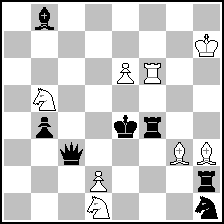 (= 8+7 ) (= 8+7 )
| | | (17) Posted by Harry Fougiaxis [Saturday, Jul 7, 2007 15:05] |
Well, in fact, I'm not joking at all. The smiley was only a sign of relief that someone could possibly think in such an extreme way as I did. I never wrote that the basic setup is better, I only say that I'm not convinced by the prize-winner, which to me is artificial and thematically impure. Sorry if this was not clear.
Ricardo managed to justify the wR/B with his clever version in post (14); you cannot remove anything in this setting. I admit I never thought to arrange the black battery so that to determine the move order and justify the black rook and subsequently the pins!
| | | (18) Posted by Jacques Rotenberg [Sunday, Jul 8, 2007 00:26] |
Harry,
I propose you this :
"Impure is beautifull !"
or if you want :
"Impure can be beautifull !"
You have a good example with model mates : sometimes it's a good thing to have models, sometimes it disturbs not to have, sometimes it does not matter not to have, and even sometimes it might be disturbing to have model mates!
| | | (19) Posted by Jacques Rotenberg [Sunday, Jul 8, 2007 00:34] |
Sorry for Ricardo, sorry for Thomas,
My preferences goes to the original setting. More dynamic, with long lines, the Bishop h3 is far better than 4 independant and static blockers, even if it "costs" from a strict economical point of vue
| | | (20) Posted by Jacques Rotenberg [Sunday, Jul 8, 2007 08:45] |
For Thomas,
You pin the Bh3, and set the cross checks aside for, all in all a poor benefit, it is not worth doing so.
| |
Read more... | Page: [Previous] [Next] 1 2 3
MatPlus.Net  Forum Forum  Helpmates Helpmates  Analysing helpmates in 2 Analysing helpmates in 2 |
|
|
|
 ISC 2024
ISC 2024 Forum
Forum  Helpmates
Helpmates  Analysing helpmates in 2
Analysing helpmates in 2 


